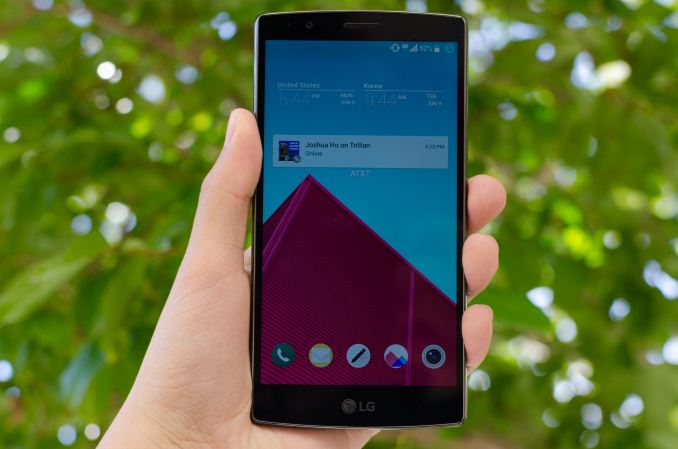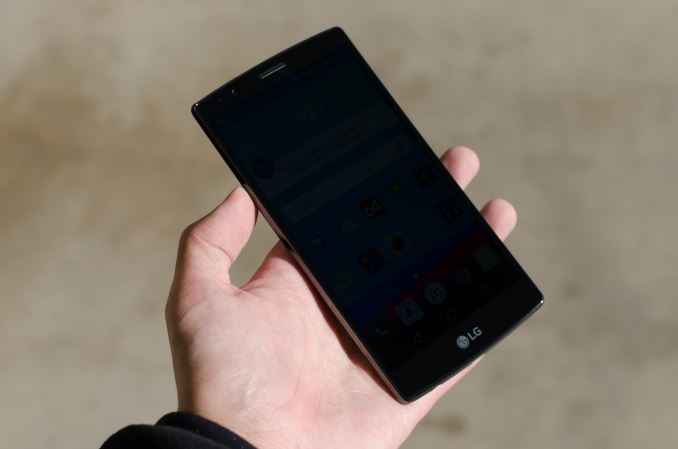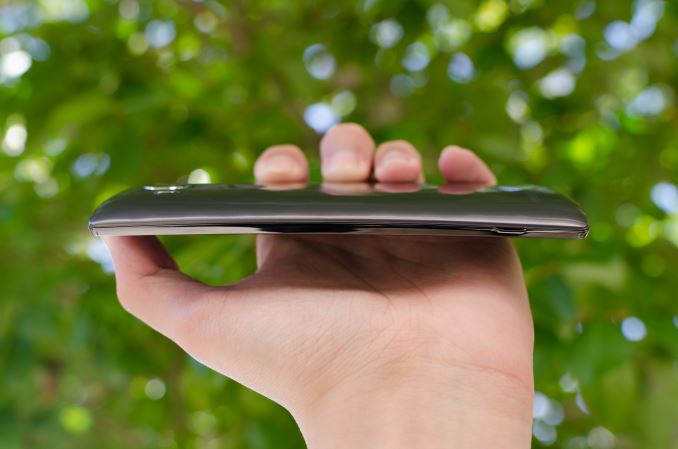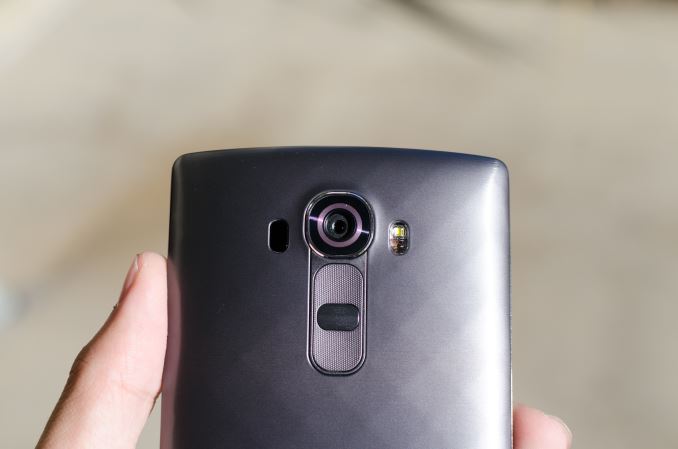The LG G4 Review
by Joshua Ho on July 30, 2015 10:00 AM EST- Posted in
- Smartphones
- Qualcomm
- LG
- Mobile
- Snapdragon 808
- LG G4

The LG G3 was probably the Android phone that was closest to getting everything right last year, but it ultimately fell short of being the “best Android phone”. The camera was the most balanced between the Galaxy S5 and One M8, the design wasn’t quite as nice as the One M8 but definitely better than the Galaxy S5, and LG’s UI fit in relatively well with Android 4.4.
The one flaw that held it back was ultimately the display, which was probably responsible for a lot of the problems that I noticed in the G3. Battery life wasn’t as good as the competition, which was probably due to the new 1440p display. The display itself wasn’t all that impressive either, as there was significant saturation compression and some sharpening effects which really hurt the quality of the display. However, in the context of 2014 flagships it was definitely a valid choice among many that year, as it seemed every device had missed the mark in some way that year.
This brings us to the G4, the successor to the G3. The LG G4 is effectively an evolution of the G3, as we’ll see in the specs below.
LG G3 |
LG G4 |
|
| SoC | MSM8974AC Snapdragon 801 4x Krait 400 @ 2.5 GHz |
MSM8992 Snapdragon 808 2xA57 @ 1.82GHz 4xA53 @ 1.44GHz |
| GPU | Adreno 330 @ 578MHz | Adreno 418 @ 600MHz |
| RAM | 3GB LPDDR3 933MHz | 3GB LPDDR3 933MHz |
| NAND | 32GB NAND (eMMC 5.0) + microSD |
32GB NAND (eMMC 5.0) + microSD |
| Display | 5.5-inch 2560x1440 IPS LCD | 5.5-inch 2560x1440 IPS LCD |
| Network | 2G / 3G / 4G Qualcomm MDM9x25 IP UE Category 4 LTE |
2G / 3G / 4G Qualcomm X10 (Integrated) UE Category 6/9 LTE |
| Dimensions | 146.3 x 74.6 x 8.9 mm 149 grams |
148.9 x 76.1 x 6.3 - 9.8 mm 155 grams |
| Camera | 13MP Sony IMX135 rear camera, 1.12 µm pixels, 1/3.06" CMOS size, F/2.4. 2-axis OIS 2.1MP F/2.0 FFC |
16MP Sony IMX234 rear camera, 1.12µm pixels, 1/2.6" CMOS size F/1.8, 3-axis OIS 8MP Toshiba T4KA3 FFC |
| Battery | 3000 mAh (11.4 Wh) replaceable | 3000 mAh (11.4 Wh) replaceable |
| OS | Android 4.4.2 with LG UI (At launch) | Android 5.1 with LGUX 4.0 (At launch) |
| Connectivity | 802.11a/b/g/n/ac + BT 4.0, USB2.0, GPS/GNSS, Slimport, DLNA, NFC | 802.11a/b/g/n/ac + BT 4.0, USB2.0, GPS/GNSS, Slimport, DLNA, NFC |
| SIM Size | MicroSIM | MicroSIM |
| Price | 199.99 USD on contract (US, launch) ~600 USD retail (US, launch) |
199.99 USD on contract (US, launch) ~649 USD retail (US, launch) |
At a high level, the major changes here have been the upgrade from the Snapdragon 801 to 808 SoC, the new “Quantum IPS” display, and a whole host of changes to the camera that seem to be the focus of the LG G4. The camera seems to really be the centerpiece of this phone, as LG has upgraded the sensor (IMX135 to IMX234), updated the optics, improved the OIS even further, and added a color sensor that looks at visible and IR spectrum to help determine white balance.
Design
As previously discussed, the G4 is very much an evolution of the G3, and this is most apparent when looking at the design of the G4. From the front, there’s relatively little that distinguishes the G4 from the G3, other than a change to the bottom bezel. The design of the phone retains its relatively thin bezels, although the removal of the two-tone bottom bezel definitely makes it feel like the bottom bezel has gotten larger. In the hand, the most noticeable change is that the corners are now noticeably more squared-off in nature. This definitely makes it harder to use the phone with one hand, to the point that I don’t really think this phone is supposed to be used with one hand.
This relatively small change ends up pushing LG over the edge for me when it comes to one-handed usability. I managed to just barely use the G3 with one hand all the time, but with the G4 anything on the left side of the display is now a real stretch to get to, and I basically can’t reach the top-left corner of the display if I’m only using the phone with my right hand. The LG G2 was a comfortably one-handed phone, and the G Pro 2 was a comfortably two-handed phone. The G4 ends up right between those two difference usage paradigms, where some situations allow for one-handed use without issue but others definitely require two hands. At any rate, for those that liked the size of the LG G3 and OnePlus One they’ll probably be right at home with the G4.
The whole phone also has a noticeable curve to it, at a radius of 3000 mm. This radius of curvature is incredibly subtle and in everyday use the phone looks flat, unlike the aggressively curved display of the Galaxy S6 edge. In practice, the real benefit of this curve is to keep the display from touching the surface of a table if the phone is set face-down. The front of the display merges with the side plastic frame, which is slightly higher than the glass to also help somewhat with drop protection. The side plastic frame itself is nothing particularly special to discuss, and is arguably a bit of a regression in feel compared to the G3 due to the glossy nature of the finish. The top of this frame has the IR receiver and transmitter to control TVs and similar appliances, and the bottom has the microUSB port, 3.5mm headphone jack, and a single microphone hole, but there’s otherwise nothing else along the sides of the phone. The rather clean sides are due to the use of rear-mounted power and volume buttons, which is a trademark of LG phones at this point.
The back of the phone is really where most of the changes are on this phone relative to the G3. The dual-tone LED flash is gone, and there’s a color spectrum sensor (RGB + IR) where the amber LED used to be. There’s also a camera hump to accommodate the thicker optics that come with a larger camera sensor, and the back cover has been redesigned on the plastic versions to have a diamond pattern which doesn’t noticeably affect the feel but causes a visual contrast that helps to distinguish this phone from the G3. Unfortunately, we haven’t been sampled the leather back cover so I don’t have anything to really discuss on that front. The single speaker of the phone is also on the back, and appears to be comparable to the G3.
Overall, the design of the LG G4 is decent, but it won’t necessarily impress in the way that the Galaxy S6 might. LG has managed to execute a plastic-bodied phone that doesn’t have any notable issues with look or feel, and given that this build enables a removable battery and microSD slot those that find those features to be a necessity will probably accept this trade-off. I personally would’ve liked to see the speaker either moved to the bottom or front of the phone, but LG has managed to evolve the design of the G3 without any noticeable regressions.














84 Comments
View All Comments
hans_ober - Thursday, July 30, 2015 - link
Hoping the Moto G review comes out in the next 2 days!Flunk - Thursday, July 30, 2015 - link
It's a shame this doesn't have a 5" 1080p display, then it would be perfect.hans_ober - Thursday, July 30, 2015 - link
Yeah, 720p is fine, but 1080p is a noticeable improvement. Stuff is visibly sharper.Bigger battery + Better GPU would have also been needed to maintain parity.
jjj - Thursday, July 30, 2015 - link
Funny how the tone changes with the manufacturer instead of being proportional with the numbers.But even more amazing is that everybody when talking iphone camera fully ignores the resolution. The thing has 2-3 times fewer pixels that the "nermal"high res phone cams. No matter the methodology of factoring in the res , the iphone still starts with at least a 20-30% handicap in the final grade. But almost everybody just ignores the res, like it's not there at all. Granted,that's the norm for any iphone flaw or missing feature.
Anyway, hope you guys stop being so lazy, get rid of every SoC banchmark you are using now and replace them with something useful.
boostern - Thursday, July 30, 2015 - link
There are other websites that already do that. We are here reading Anandtech because we like "every SoC benchmark", for us it is useful.hans_ober - Thursday, July 30, 2015 - link
Yeah, many websites give you a tldr, which appeals to a normal user: "the phone is fast blah blah"Then you have other websites that post benchmarks and stuff for "tech guys" : "octa core.. 1080p blah "
Aand then there's Anandtech. Don't get me started on their deep-dives.
Impulses - Thursday, July 30, 2015 - link
Hmm, if it were something like 12mp vs 16mp+ I'd say it'd be fair to downplay res, but 8 vs 16 and beyond really does make a big difference when it comes to printing or even cropping for tighter framing online.Nerdy Geek - Thursday, July 30, 2015 - link
I am surprised that you say the LG G4 and jesusPhone+ have a better camera. Both DPreview and DXO mark says otherwise by a large margin for the S6 (except perhaps in manual mode on the G4 in low light). From my short time with a S6 Edge I would agree (also had 6 and 6+ for about 2 weeks)grayson_carr - Thursday, July 30, 2015 - link
I'm surprised too. I used the Galaxy S6 for 2 months and the G4 for 1 month and did several side by side camera comparisons. I thought the Galaxy S6 had a better auto mode and took better pictures in good lighting, and the G4 had a superior manual mode and took better pictures in low light. In auto mode in daylight, I found that the G4 was too hesitant to use HDR, probably because it is rather slow compared to the real time HDR on the S6. And the G4 often produced either overly soft or overly sharpened photos.phoenix_rizzen - Thursday, July 30, 2015 - link
Took them a couple years and several phone iterations, but it looks like they may have finally come out with an upgrade for the LG G2.